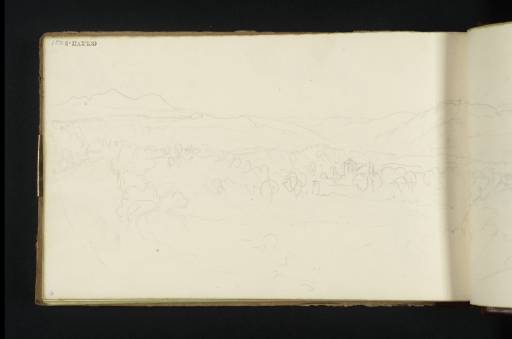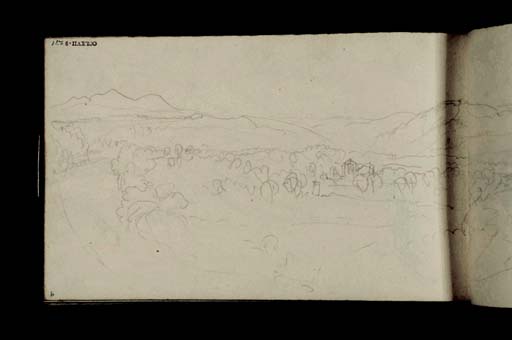J.M.W. Turner
>
1830-35 Annual tourist
>
Scotland 1831
>
Abbotsford Sketchbook
>
Artwork
Joseph Mallord William Turner Dryburgh Abbey 1831
Image 1 of 2
Joseph Mallord William Turner,
Dryburgh Abbey
1831
Joseph Mallord William Turner 1775–1851
Folio 9 Recto:
Dryburgh Abbey 1831
D25942
Turner Bequest CCLXVII 9
Turner Bequest CCLXVII 9
Pencil on off-white wove writing paper, 113 x 185 mm
Inscribed in blue ink by John Ruskin ‘9’ bottom left inverted and ‘271’ top left inverted
Stamped in black ‘CCLXVII – 9’ top left inverted
Inscribed in blue ink by John Ruskin ‘9’ bottom left inverted and ‘271’ top left inverted
Stamped in black ‘CCLXVII – 9’ top left inverted
Accepted by the nation as part of the Turner Bequest 1856
References
1909
A.J. Finberg, A Complete Inventory of the Drawings of the Turner Bequest, London 1909, vol.II, p.857, CCLXVII 9, as ‘Dryburgh Abbey. See Engraving, Scott’s Poems 1833.’.
1972
Gerald E. Finley, ‘J.M.W. Turner and Sir Walter Scott: Iconography of a Tour’, Journal of the Warburg and Courtauld Institutes, vol.35, 1972, p.382 note 138.
1974
Martin Butlin, Andrew Wilton and John Gage, Turner 1775–1851, exhibition catalogue, Royal Academy, London 1974, p.100 under cat.290.
1982
Francesca Irwin, Andrew Wilton, Gerald Finley and others, Turner in Scotland, exhibition catalogue, Aberdeen Art Gallery and Museum 1982, p.52 under cat.69.
This sketch of Dryburgh Abbey, between Selkirk and Kelso in the Scottish Borders was made across this page and folio 8 verso (D25941; CCLXVII 8a) with the sketchbook inverted. It has been recognised as the basis for Turner’s watercolour design for the frontispiece to volume 5 of Sir Walter Scott’s Poetical Works: Dryburgh Abbey circa 1832 (watercolour, Tate N05241).1 While the composition of the watercolour is closest to the present drawing, it has been argued that elements of two further sketches have been incorporated, making this a synthesis of the three sketches (folios 68 verso–70; D2049–D26051; CCLXVII 70a–72).2 However, those other two sketches are not from the south. The watercolour is therefore based on the present sketch, and on a sketch on folio 69 verso (D26051; CCLXVII 71a) which shows a close-up sketch of the abbey from the south.
The view is from across the Tweed near St Boswells, and reveals the U-shaped twist in the river at this point so that the abbey is surrounded by water on three sides. The abbey is at the middle of folio 9 with the window of the south transept and parts of the choir being the most complete part of the ruin. The twin peaks of the Eildon Hills are shown in the distance at the left, and across the inner edge of the two pages is the hill near Bemerside where the statue of William Wallace stands commissioned by the eleventh Earl of Buchan; this can be seen on folio 9 verso (D25943; CCLXVII 9a).
The position of the abbey, hills and river in the watercolour are taken from this sketch, but the details of the abbey are from folios 9 verso, and 71 verso. There is a view of the same twist in the Tweed, though seen from a higher vantage point, on folio 1 verso (D25930; CCLXVII 1a), and there are close-up studies of the abbey on folios 71 to 73 verso (D26050–D26059; CCLXVII 73–75a).
This was Turner’s second visit to Dryburgh, following his first in 1797 (see Tate D00929 and D00971; Turner Bequest XXXIV 23 and 62). This time he was accompanied by Robert Cadell, Archibald Todd of Drygrange and his two sons Alick and Jamey. Cadell recorded in his diary that Turner made ‘a good many views of the abbey’ from nearby and ‘various Sketches from [the] Southern side of the River.’3
Thomas Ardill
September 2009
Anne Lyles, Turner: The Fifth Decade: Watercolours 1830–1840, exhibition catalogue, Tate Gallery, London 1992, p.44.
How to cite
Thomas Ardill, ‘Dryburgh Abbey 1831 by Joseph Mallord William Turner’, catalogue entry, September 2009, in David Blayney Brown (ed.), J.M.W. Turner: Sketchbooks, Drawings and Watercolours, Tate Research Publication, December 2012, https://www


